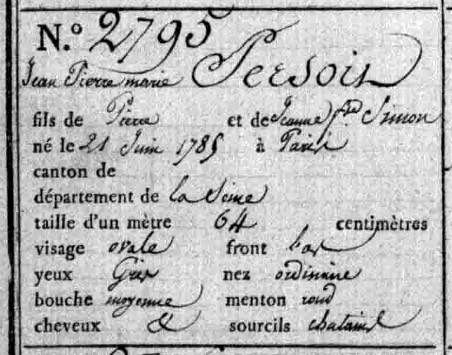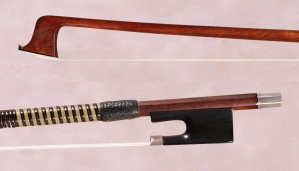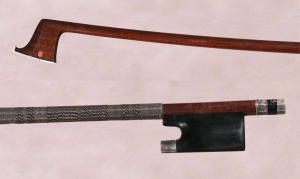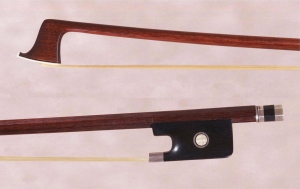As Duane Rosengard and I near completion of our book TOURTE, new research on Jean Pierre Marie Persoit yields prescient information as we connect his earliest bowmaking to the Tourte brothers. Having personally spent countless hours in the Paris archives searching for his death and imagining that his birth would never be found, I am ecstatic to learn both over the course of a week.
Persoit was born on 21 June 1785, according to his military inscription records newly discovered by Duane and illustrated below. He entered the army on 14 Brumaire An XIV (5 November 1805) as a “voltigeur”, an infantryman. Injured by a bullet in the battle of Iéna in October 1806, his recovery is not detailed but upon his return he was no longer put into the front lines. In September 1807 Persoit rose to the position of corporal and remained available later as a reservist. His discharge likely occurred in 1808.

A description of Persoit from his newly discovered military inscription record: 1.64 meters tall, oval face, low forehead, grey eyes, an ordinary nose, an average mouth, a round chin, hair and eyelashes brown…(click to enlarge).
Bow #1 illustrated herein is a Nicolas Léonard Tourte made by Persoit, or “showing the hand of Persoit”. The model of the head is precisely what we expect of the very late work of Tourte l’Ainé, but a close look reveals the much more refined and confident hands of another maker. The working mannerisms expressed in the cut of the head mortice, the chamfers and the interior of the frog reveal the work of Persoit. This is a case of applying knowledge of Persoit’s later work back to this circa 1800-1805 period. Other bows by Persoit of this time – some more individual, some showing a François Tourte influence – can now be accepted as Persoit’s early and very fine work.

A violin bow by Persoit made for Nicolas Léonard Tourte.
Not long after his military discharge, François Jeanne Faverot, Persoit’s wife, gave birth to their first child, Françoise Louise, on 22 October 1809. Persoit’s bows for about the next decade or so are more of the Lupot type – octagonal, a little short in length (usually) and with angular, sometimes “hatchety” heads.
In a Justice of the Peace act from 1816, Persoit was described as a “mechanicièn”, likely a brief or part time industry. A “mechanicièn” is one who makes or repairs machines but might also be an engineer or an inventor. This points to Persoit as the prime mover with J.B. Vuillaume’s self-rehairing and metal bows emanating from the mid-1830s. (Persoit bows made for Vuillaume from the 1820s may very rarely be seen.)
The Justice of the Peace act itself presented Persoit as the defendant in an action brought forward by Paul Louis Faverot, his brother-in-law by virtue of Persoit’s wife, Françoise Jeanne Faverot. At issue was that the latter’s wife had deposited household goods of their own into Persoit’s abode and Mr. Faverot wanted their return or a payment of 800 francs! (This was a heavy sum when one considers that just a few years later the base price for Tourte bows was 24 francs.)
Persoit prevailed, paying court costs of only 3 francs, 70 centimes. Did the household goods settle a debt? Were they returned? These questions were not answered. Perhaps it was simply an overblown domestic squabble between Faverot and his wife.
An extremely rare and fine Persoit self-hairing bow is our next illustrated bow #2. A mature period and great viola bow is presented as bow #3.

An extremely rare self-hairing bow by Persoit.

A fine viola bow from Persoit’s mature period.
I last found Persoit in Paris signing as a witness and described as a luthier at a marriage on 26 March 1859 at the Paroisse St.-Éloi. My continued searches for his death were not fruitful. In fact, however, at some following point he moved to Villers-Cotterêt, a small village 80 km north of Paris of about 11,000 inhabitants, about 3,500 in Persoit’s time. It was there where he died on 29 December 1866. The death notice states that he was there “momentarily” and was a worker in “papier peint”, wallpaper. At his age then of 81 (written as 80 in the act) we presume that he was more likely involved in the making of the papers than perhaps up on a ladder hanging it!
As the research never ends, one hopes to find out if this great bowmaker made more bows (and where!) in the nearly eight year interim between his witnessing the 1859 marriage and his death at the end of 1866. But at any rate, we now know and appreciate more fully this unique man and his remarkable life.
With thanks to genealogist Mme Anne-Sophie Chevalier, whose brilliant and persistent work found Persoit’s final resting place.